Friday, November 30, 2018
Wednesday, November 28, 2018
Gardening Christmas Gifts
The post Gardening Christmas Gifts appeared first on Miss Smarty Plants.
What’s on my list for gardening Christmas gifts this year? Oh boy, read on for some great ideas! I’ve been trying really hard to scale back, but for the loved ones in your life a thoughtful gardening Christmas gift will make their day– and return throughout the year to remind them of you!
- This might sound boring, but its hard to beat a gift certificate to a local garden center! Yes, I know what you’re thinking, that this would be the easy way out, but what if you include yourself and a lunch after? While this gardening Christmas gift would make your loved one happy now, the true gift would be spending time together in the spring shopping for plants.
- For a stocking stuffer, how about this Hanging Glass Bulb Vase from Ferry Morse? At only $3.99 each, these would be a great unique gift for just about anyone!
- I hesitate to include weeding products on here, but the gardener in your life is sure to appreciate the thought that went into selecting the CobraHead weeder for their use! This handy tool is so easy to use and is very efficient at getting to weeds that have a large root system without tearing up nearby plants.
- You know what gardening Christmas gifts I would love? A gift certificate to Brent and Becky’s Bulbs. For one thing, their catalog reads like a book and I know the gardener in your life will enjoy reading these lively plant descriptions before choosing their purchase. Be warned: they are going to spend more than your gift certificate!
- One of my favorite gardening Christmas gifts last year was a hummingbird feeder. There are countless styles and price points for these, but it really doesn’t take much to attract hummingbirds to your yard.
- Finally, does your gardener already have a fountain in their garden? This is a great way to add a focal point and attract wildlife to the garden. There are many to chose from, but high on my list right now is this fountain at Wayfair. I love all of these Campania products, so selecting one might be hard but you really can’t go wrong.
I hope these helps your find the perfect gardening Christmas gifts for this year! If you need more ideas, my friends at the Washington Gardener and Small Garden News have put together these great lists.
- Small Garden News Holiday List: https://www.smallgardennews.com/gifts-for-gardeners-in-winter/
- Washington Gardener Gift for Gardeners: https://washingtongardener.blogspot.com/2018/11/gifts-for-gardeners-gardening-gift.html
The post Gardening Christmas Gifts appeared first on Miss Smarty Plants.
from Miss Smarty Plants https://ift.tt/2QnevQD
Monday, November 19, 2018
Prepare like a Pro – 4 Winter Landscaping Tips
As the temperatures continue to fall, daylight hours get shorter, and the final leaves begin to fall off the trees. One might think this marks the end to another season in the landscape. In one aspect, this is correct; the growing season is over. But, there is still much you should do to the landscape to prepare it for the stresses of Winter. Here’s 4 Winter landscaping tips from a pro.
Winter Landscaping Tip #1 – Dormant Season Pruning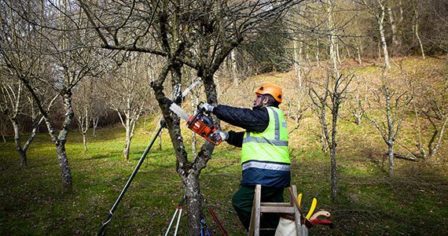
Pruning of your trees and shrubs during the growing season, in most cases, is a must. To keep the plant clean and shaped, cut back some of the new growth that comes out as it grows.
Once the plant goes dormant however, one would think that there is no need to prune anymore. That is not the case! When there are no longer any leaves on the trees and shrubs, you can easily see up into the plants. This inspection may reveal a very thick and densely branched tree or shrub. In most cases, this is not an ideal growth habit for the plant. Thinning to reduce that density of the branches will help the overall health of the tree or shrub.
Another benefit that dormant season pruning has for you is that the debris that you create from the pruning is substantially less because there are no leaves to worry about. In some cases, this translates to a lower cost to have a professional do the job. Less debris means less for them to haul away.
Winter Landscaping Tip #2 – Perennial Cut Back
Another type of plant that benefits from pruning are perennials. As freezing temperatures hit, most Spring, Summer and Fall blooming perennials begin to store their energy for the Winter down in their root system. The result is a brown plant on top. You could leave these ugly, brown remnants of the perennial in your landscape, but that isn’t very visually appealing. Also, having a lot of dead foliage in your garden provides great places for rodents to hide and feed on the root system of your plants. The best thing to do is to cut back the foliage remnants of your perennials. Your final result will be plants cut to a few inches about the ground level.
Winter Landscaping Tip #3 – Fertilization of Trees and Shrubs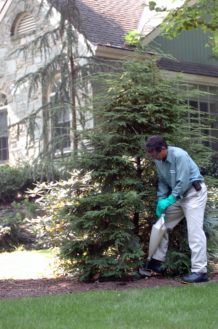
Giving your trees and shrubs the proper nutrition is vital to the success of their growth and structure. With a low amount of nutrition in the soil, many plants will struggle to stay healthy. Plants will lack the proper color foliage and have limited blooms. Additionally, having a stressed tree or shrubs increases the chance of disease or insect infestations. There are two main type of fertilization that can be done in the Fall that help the landscape. A liquid fertilization can be performed around the drip line of a tree or shrub and instantly puts the nutrients into the soil. A granular fertilization is also placed around the drip line of the tree or shrub and the product will slowly dissolve into the soil.
Either option is a good choice for the Fall. The vital nutrients that are in the fertilizers will remain in the soil until the Spring time. This means these nutrients are ready be there to be taken up once the plant emerges from Winter. Fertilization can be done in the Spring time for trees and shrubs too, but it can take some time in order for nutrients to be absorbed. So, having the greatest impact starting the Spring season off would be a Fall fertilization.
Winter Landscaping Tip #4 – Fall Planting
Once you have gone through your landscape pruning your trees and shrubs, cutting back your perennials, and fertilized the beds, you may begin to starting thinking about what next Spring could bring and what you could do now to fill in a few areas that just seem to be missing something. A good thing to do in the fall is planting of perennials, trees and shrubs.
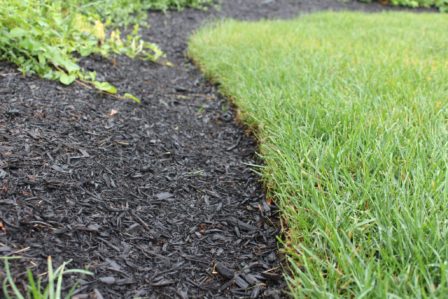 A large benefit of planting in the fall is the reduced amount of watering you will need to do. When you plant something in the spring or early summer, the foliage and root system are actively growing. This means a large amount of water to keep them going. When you plant in the Fall, perennials, trees and shrubs are just about dormant. Because the ground stays moist with more frequent rainfalls it takes the watering labor away from you.
A large benefit of planting in the fall is the reduced amount of watering you will need to do. When you plant something in the spring or early summer, the foliage and root system are actively growing. This means a large amount of water to keep them going. When you plant in the Fall, perennials, trees and shrubs are just about dormant. Because the ground stays moist with more frequent rainfalls it takes the watering labor away from you.
Also, when planting in the Fall make sure to provide your new and existing plants with a good layer of mulch to help insulate the soil. This practice helps reduce the chance of heaving from the alternating freezing and thawing of the ground.
Being outside in late Fall weather may not always be pleasant, but making sure your trees and shrubs are protected from the potential damages of the Winter are necessary. Making sure you tackle each of these steps above will help to ensure that your landscape is properly protected this Winter. If you’d like a free consultation about Winter landscaping, please Contact Us.
The post Prepare like a Pro – 4 Winter Landscaping Tips appeared first on Tomlinson Bomberger.
from Tomlinson Bomberger https://ift.tt/2Trk92L
Monday, November 12, 2018
The Benefits of Landscape Lighting on Your Commercial Property
Your commercial property is extremely visible during the daylight hours. Signage is easy to read. Turf glimmers with fresh morning dew. Plants are healthy and green with touches of fall blooms. In the sunlight, your property shines.
However, you might have noticed those daylight hours do not stay for long. As evening approaches visibility isn't as clear, and visitors are left scrambling to their cars or designated areas.
So, how can additional hours of light help your Atlanta commercial property? For starters, it adds an extra security feature. This reassures employees and tenants that building owners and managers are thinking about their well-being.
from HighGrove's Atlanta Commercial Landscaping Blog https://ift.tt/2DeNdoy
Wednesday, November 7, 2018
Winter Containers
The post Winter Containers appeared first on Miss Smarty Plants.
I know it seems so early, but now is a really good time to make your winter containers. These simple instructions will show you just how easy it is to add some holiday cheer and interest to your garden with very easy winter containers.
At the end of the summer and a good part into fall, it seems like this is a now or never type of project. As in, if I don’t do it now I will never do it! These bare planters need some sprucing up and today was the day to get it done.
I’ve always had good intentions of doing this, but it seems like it just hasn’t taken priority. I started by gathering some broken branches from evergreens around our home, looking for branches that were crossing or were just starting to get in the way of the lawn mower. I know that a variety of textures and even colors will make this more interesting and was able to find a nice assortment.
The centerpiece for these planters on each side of our front steps are some bright red upright branches. A special type of dogwood perhaps? Nope, just some sucker branches from a tree that I spray painted red last year. They still look great so I am reusing them again.
Many of the evergreens that I used for this were broken branches that needed to be cleaned up. This seemed like a great reason to do so! I also trimmed excessively long, or in the way, branches too.
The recent rain makes inserting these branches into the wet soil very easy and also makes it easy enough to point the stems in different directions to create a full look. At some point, hopefully very far away, the soil will freeze and add more strength to keep these winter containers in all season. 
Some branches, like the Colorado Blue Spruce shown below make great accents. I had a couple of containers still looking nice so I simply left the calibrachoa flowers and stuck these evergreens in around it. They will need an accent once the flowers are gone, but for now it will do.
Overall, I think these winter containers turned out great for my first attempt. The entire project took less than an hour and I will be able to enjoy them all winter long. Want more inspiration? I love reading Deborah Silver’s posts on Dirt Simple about her projects, many of which are fabulous seasonal containers. So make the most of this time of year and collect your own pieces for beautiful winter containers this season.
The post Winter Containers appeared first on Miss Smarty Plants.
from Miss Smarty Plants https://ift.tt/2yVEBAs
Thursday, November 1, 2018
3 Tips to Prepare Your Landscape for Winter
We often receive calls from clients in Spring and Summer, concerned about the health of their beloved landscape plants. Maybe it was a planting done in honor of a departed loved one, or perhaps it’s a hedgerow planted for privacy. Whatever the reason, many people are concerned because of dead or damaged parts of the plant. And often, the culprit is damage done the prior Winter. Read up on 3 tips to prepare your landscape for Winter.
Winter Protective Sprays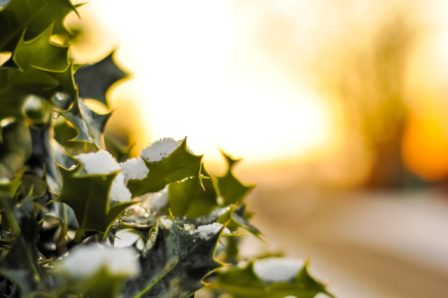
This practice isn’t very common Central PA, but should be. Basically, the idea is to help prevent damage to evergreen plants in your landscape by providing them with some protection from the extreme temperatures that can cause damage in the Winter.
Let’s review some basics of plant biology. All plants go through a process where they take in water through their root systems and naturally release some through leaf or needle tissue. This process is called “transpiration.” If you’ve ever been on a hike on a summer day, you may have noticed it is more humid walking through a wooded area than an open field. This is due to transpiration – the trees are allowing a small amount of water to basically evaporate through the leaf tissue.
Winter damage to landscape plants occurs when plants transpire faster than they can take in more moisture. When the ground is frozen, plants can’t bring in moisture quickly enough to prevent damage from transpiration.
That’s where anti-desiccant sprays, also known as “Winter Protection” sprays, come into play. These sprays basically help to seal in the moisture present in the leaf/needle tissue. This coating slows the transpiration process with the goal of ensuring that the plant can intake and release the proper amount of water.
Plants to Treat
According to Michigan State University, there are specific plants you should target. Short-needled conifers (Eastern hemlock, Alberta spruce, Serbian spruce, juniper, etc.) should be sprayed. Also, broadleaf evergreens (boxwoods, rhododendrons, and hollies) are also at risk of winter damage and should be treated.
Preventing too much moisture from being released should help prevent Winter damage to the plant material. It’s not foolproof, but done regularly and well, makes a big difference. This is particularly important for plants susceptible to other pest or disease issues. For example, a series of well-timed Winter Protective sprays for boxwoods may reduce the risk of contracting boxwood blight. There’s no treatment currently available for boxwood blight, so reducing the likelihood of contraction can help prolong the life of the plant. This is a great way to ensure a healthy landscape for Winter.
 Fertilization
Fertilization
The growing season brings a whole host of challenges to your landscape. There are always a number of stressors on your plants throughout the season.
These include pest pressure, disease pressure, heat stress, over watering, under watering, and depleted soil nutrients to name a few. That doesn’t even include any pressure the plant feels from pruning (proper or improper), damage from traffic compacting the soil, etc.
Again, a quick lesson in plant biology. Many plants store up a nutrient reserve, like a “rainy day” fund. When they’re under severe stress, they tap into that “fund” in order to help them get through a rough patch. You’ll often see this with trees that are stressed; they will suddenly sprout new “branches” much lower on their trunks or branches. The only place you should see leaves emerging on a tree is at the end of a branch. When these little “water sprouts” emerge off the trunk or lower on branches, you know the tree is under stress and is utilizing this nutrient reserve to try and compensate.
Fertilization makes sure that these “rainy day funds” on your landscape plants are topped off. It helps the plants to fight off stress from the Winter and emerge healthy and full the following Spring if you’ve fertilized late Fall. All plants in your landscape can benefit from this service, but especially those that aren’t “looking good.” If your plant doesn’t look “normal,” you should probably have it fertilized to help it recover from stress. Don’t overlook this important step!
Make Sure Plants Are Sited Properly
This one is a little tricky, especially for landscapes that are already well established. The principle is pretty simple: don’t place plants in places that are bad for them during the Winter.
It sounds easy but is harder than it looks, as there’s a lot to consider. Even an untrained professional can look at certain things and predict where problems will arise. For example, where do you “dump” your snow when you shovel it? Most of us put it right along the edges of the walkway or driveway, right?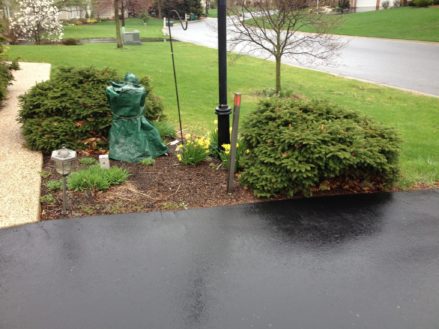
Well, is that pattern of snow piling up over and over again going to put additional stress on the plant you want to go there? If so, you may want to consider placing that particular plant in another location.
Other considerations have to do with the plants themselves. Does the plant you want need full sun or partial shade? What’s the drainage of like? Some plants require great drainage, while others prefer a moist soil. What about soil pH? Again, some like a balanced soil and other plants require an acidic or alkaline soil.
An important consideration for Winter is the salt tolerance of plants. Some plants do not do well with high salt content in the soil, like white pines. Plants sited along a walkway or roadway (where plow trucks will be close) that do not respond well to high levels of salt could be problematic.
If you’re unsure of plant selection and placement, consultation with a professional might be in your best interest to ensure the overall health of the landscape. If you live locally and would like to speak with us about preparing your landscape for Winter, you can contact us here.
The post 3 Tips to Prepare Your Landscape for Winter appeared first on Tomlinson Bomberger.
from Tomlinson Bomberger https://ift.tt/2DiENh5
First Lady Jill Biden and the White House Garden
Now that almost everyone concedes that the Bidens will be moving into the White House soon (hopefully, soon enough!), local garden writers ...

-
Now that almost everyone concedes that the Bidens will be moving into the White House soon (hopefully, soon enough!), local garden writers ...
-
Neither sorrow nor fear has diminished home gardening’s potential to heal during this pandemic spring. Chris Beytes of Grower Talks, the...
-
One of the most common calls we get throughout the season is about “patchy” looking lawns. These calls can come from current clients or pot...









